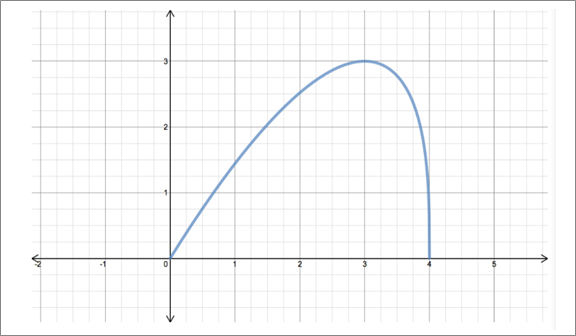
Concept explainers
a.
To graph: the curve
a.
Answer to Problem 21E
Explanation of Solution
Given information: Given curve is
Calculation:
Graph of the given curve

b.
To compute: the lengths of inscribed polygons with n = 1, 2 and 4 sides.
b.
Answer to Problem 21E
The
The polygon with side two, n =2 length
The polygon with side four, n =4 length
Explanation of Solution
Given information: Given curve is
Calculation:
The polygon with side is just the line segment joining (0, f (0 )) and (4, f (4)) = (4, 0). So its length is 4.
The polygon with two sides joins (0, 0), (2, f (2))=(2,
So its length is
The polygon with four sides joins the points (0,0) , (1,

c.
To set up: an integral for the length of the curve.
c.
Answer to Problem 21E
Explanation of Solution
Given information: Given curve is
Formula Used:
Arc Length Formula:
If f ‘( x ) is continues on [a ,b] then the length of the curve y = f ( x ) ,
Calculation:
To find the length of the given curve
Compute f ‘( x ):
d.
To find: the length of the curve to four decimal places using calculator and compare with the approximation in part (b).
d.
Answer to Problem 21E
Explanation of Solution
Given information: Given curve is
Calculation:
From part (c),
The problem specifically asks to use a calculator.
This Integral approximates to 7.79879.
In part ( b) , approximated the length of the curve using polygons with 1 ,2 and 4 sides.
All these approximations were underestimates.
Chapter 6 Solutions
Single Variable Calculus: Concepts and Contexts, Enhanced Edition
 Calculus: Early TranscendentalsCalculusISBN:9781285741550Author:James StewartPublisher:Cengage Learning
Calculus: Early TranscendentalsCalculusISBN:9781285741550Author:James StewartPublisher:Cengage Learning Thomas' Calculus (14th Edition)CalculusISBN:9780134438986Author:Joel R. Hass, Christopher E. Heil, Maurice D. WeirPublisher:PEARSON
Thomas' Calculus (14th Edition)CalculusISBN:9780134438986Author:Joel R. Hass, Christopher E. Heil, Maurice D. WeirPublisher:PEARSON Calculus: Early Transcendentals (3rd Edition)CalculusISBN:9780134763644Author:William L. Briggs, Lyle Cochran, Bernard Gillett, Eric SchulzPublisher:PEARSON
Calculus: Early Transcendentals (3rd Edition)CalculusISBN:9780134763644Author:William L. Briggs, Lyle Cochran, Bernard Gillett, Eric SchulzPublisher:PEARSON Calculus: Early TranscendentalsCalculusISBN:9781319050740Author:Jon Rogawski, Colin Adams, Robert FranzosaPublisher:W. H. Freeman
Calculus: Early TranscendentalsCalculusISBN:9781319050740Author:Jon Rogawski, Colin Adams, Robert FranzosaPublisher:W. H. Freeman
 Calculus: Early Transcendental FunctionsCalculusISBN:9781337552516Author:Ron Larson, Bruce H. EdwardsPublisher:Cengage Learning
Calculus: Early Transcendental FunctionsCalculusISBN:9781337552516Author:Ron Larson, Bruce H. EdwardsPublisher:Cengage Learning





